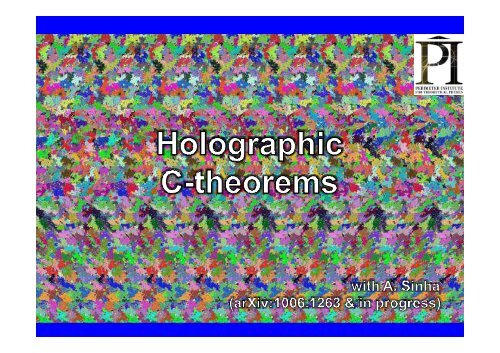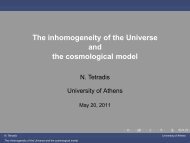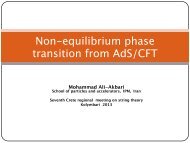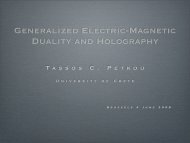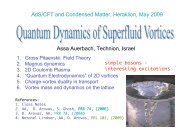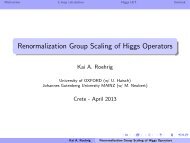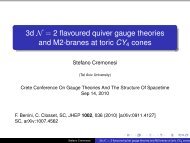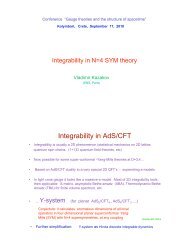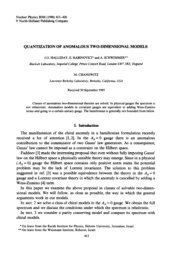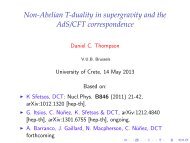Holographic c-theorems
Holographic c-theorems
Holographic c-theorems
Create successful ePaper yourself
Turn your PDF publications into a flip-book with our unique Google optimized e-Paper software.
Motivation:<br />
“role of higher curvature interactions on AdS/CFT calculations”<br />
Overview:<br />
1. Introductory remarks on c-theorem and CFT’s<br />
2. <strong>Holographic</strong> c-theorem I: Einstein gravity<br />
3. <strong>Holographic</strong> c-theorem II: Quasi-topological gravity<br />
4. <strong>Holographic</strong> c-theorem III: Higher curvature theories<br />
5. a d* , Entanglement entropy and Beyond<br />
6. Concluding remarks
Zamolodchikov c-theorem (1986):<br />
• renormalization-group (RG) flows can seen as one-parameter<br />
motion<br />
in the space of (renormalized) coupling constants<br />
with beta-functions as “velocities”<br />
• for unitary, renormalizable QFT’s in two dimensions, there exists<br />
a positive-definite real function of the coupling constants :<br />
1. monotonically decreasing along flows:<br />
2. “stationary” at fixed points : :<br />
3. at fixed points, it equals central charge of corresponding CFT
C-<strong>theorems</strong> in higher dimensions<br />
d=2:<br />
d=4:<br />
and<br />
• in 4 dimensions, have three central charges:<br />
• do any of these obey a similar “c-theorem” under RG flows<br />
-theorem: is scheme dependent (not globally defined)<br />
-theorem: there are numerous counter-examples
C-<strong>theorems</strong> in higher dimensions<br />
d=2:<br />
d=4:<br />
and<br />
• in 4 dimensions, have three central charges:<br />
• do any of these obey a similar “c-theorem” under RG flows<br />
-theorem: proposed by Cardy (1988)<br />
• numerous nontrivial examples, eg, perturbative fixed<br />
points (Jack & Osborn), SUSY gauge theories (Anselmi et al)
SUSY example:<br />
(Anselmi, Freedman, Grisaru & Johansen, hep-th/9708042)<br />
• SU(N c ) supersymmetric QCD with N f flavors of massless quarks<br />
with<br />
• in UV, asymptotically free:<br />
• in IR, flows to nontrivial conformal fixed point:
SUSY example:<br />
(Anselmi, Freedman, Grisaru & Johansen, hep-th/9708042)<br />
• SU(N c ) supersymmetric QCD with N f flavors of massless quarks<br />
with
C-<strong>theorems</strong> in higher dimensions<br />
d=2:<br />
d=4:<br />
and<br />
• in 4 dimensions, have three central charges:<br />
• do any of these obey a similar “c-theorem” under RG flows<br />
-theorem: proposed by Cardy (1988)<br />
• numerous nontrivial examples, eg, perturbative fixed<br />
points (Jack & Osborn), SUSY gauge theories (Anselmi et al)<br />
• holographic field theories with gravity dual
C-<strong>theorems</strong> in higher dimensions<br />
d=2:<br />
d=4:<br />
and<br />
• in 4 dimensions, have three central charges:<br />
• do any of these obey a similar “c-theorem” under RG flows<br />
-theorem: proposed by Cardy (1988)<br />
• numerous nontrivial examples, eg, perturbative fixed<br />
points (Jack & Osborn), SUSY gauge theories (Anselmi et al)<br />
• holographic field theories with gravity dual<br />
• no completely general proof<br />
• counterexample proposed: Shapere & Tachikawa, 0809.3238
Counterexample to a-theorem:<br />
(Shapere & Tachikawa, 0809.3238)<br />
• flow between two N = 2 superconformal gauge theories<br />
UV: gauge group SU(N c +1) with N f =2N c fundamental hyper’s<br />
IR: gauge group SU(N c ) with N f =2N c fundamental hyper’s (m=0)<br />
( )<br />
• loophole: accidental U(1) symmetry appears in the IR limit<br />
• Possibilities:<br />
i) no theorem exists<br />
Today’s Talk<br />
ii) “C-theorem” exists but C(g*) ≠ a<br />
iii) “C-theorem” exists and C(g*) = a,<br />
but theorem needs fine-print for d>2<br />
iv) something more interesting<br />
universal<br />
not universal
C-<strong>theorems</strong> in higher dimensions<br />
d=2:<br />
d=4:<br />
and<br />
• in 4 dimensions, have three central charges:<br />
• do any of these obey a similar “c-theorem” under RG flows<br />
-theorem: proposed by Cardy (1988)<br />
• numerous nontrivial examples, eg, perturbative fixed<br />
points (Jack & Osborn), SUSY gauge theories (Anselmi et al)<br />
• holographic field theories with gravity dual<br />
• no completely general proof<br />
• counterexample proposed: Shapere & Tachikawa, 0809.3238
Motivation:<br />
“role of higher curvature interactions on AdS/CFT calculations”<br />
Overview:<br />
1. Introductory remarks on c-theorem and CFT’s<br />
2. <strong>Holographic</strong> c-theorem I: Einstein gravity<br />
3. <strong>Holographic</strong> c-theorem II: Quasi-topological gravity<br />
4. <strong>Holographic</strong> c-theorem III: Higher curvature theories<br />
5. a d* , Entanglement entropy and Beyond<br />
6. Concluding remarks
<strong>Holographic</strong> RG flows:<br />
(Freedman, Gubser, Pilch & Warner, hep-th/9904017)<br />
(Girardello, Petrini, Porrati and Zaffaroni, hep-th/9810126)<br />
• assume stationary points: matter fields fixed and<br />
• consider metric:<br />
(eg, scalar field: )<br />
• at stationary points, AdS 5 vacuum: with<br />
• RG flows are solutions starting at one stationary point and<br />
ending at another<br />
UV<br />
IR
<strong>Holographic</strong> RG flows:<br />
• for general flow solutions, define:<br />
(Freedman, Gubser, Pilch & Warner, hep-th/9904017)<br />
(Girardello, Petrini, Porrati and Zaffaroni, hep-th/9810126)<br />
Einstein equations<br />
null energy condition<br />
• at stationary points, and hence
<strong>Holographic</strong> RG flows:<br />
• for general flow solutions, define:<br />
(Freedman, Gubser, Pilch & Warner, hep-th/9904017)<br />
(Girardello, Petrini, Porrati and Zaffaroni, hep-th/9810126)<br />
Einstein equations<br />
null energy condition<br />
• at stationary points, and hence<br />
• using holographic trace anomaly:<br />
supports Cardy’s conjecture<br />
• for Einstein gravity, central charges equal :<br />
(e.g., Henningson & Skenderis)
<strong>Holographic</strong> RG flows:<br />
(Freedman, Gubser, Pilch & Warner, hep-th/9904017)<br />
• same story is readily extended to (d+1) dimensions<br />
• defining:<br />
Einstein equations<br />
null energy condition<br />
• at stationary points, and so<br />
• using holographic trace anomaly: central charges<br />
(for even d! what about odd d)<br />
(e.g., Henningson & Skenderis)
Motivation:<br />
“role of higher curvature interactions on AdS/CFT calculations”<br />
Overview:<br />
1. Introductory remarks on c-theorem and CFT’s<br />
2. <strong>Holographic</strong> c-theorem I: Einstein gravity<br />
3. <strong>Holographic</strong> c-theorem II: Quasi-topological gravity<br />
4. <strong>Holographic</strong> c-theorem III: Higher curvature theories<br />
5. a d* , Entanglement entropy and Beyond<br />
6. Concluding remarks
Improved <strong>Holographic</strong> RG Flows:<br />
• add higher curvature interactions to bulk gravity action<br />
provides holographic field theories with, eg,<br />
so that we can clearly distinguish evidence of a-theorem<br />
(Nojiri & Odintsov; Blau, Narain & Gava)<br />
more generally broadens class of dual CFT’s
Improved <strong>Holographic</strong> RG Flows:<br />
• engineering the gauge theory: gauge groups, field content, . . .<br />
versus<br />
• engineering the CFT: parameters in n-point correlators, . . .<br />
graviton,<br />
stress tensor,<br />
• gravitational action naturally connected to correlators of<br />
R +<br />
R n<br />
+<br />
• adding higher curvature terms changes both parameter values<br />
and also form of n-point functions in dual CFT’s
Improved <strong>Holographic</strong> RG Flows:<br />
• add higher curvature interactions to bulk gravity action<br />
provides holographic field theories with, eg,<br />
so that we can clearly distinguish evidence of a-theorem<br />
(Nojiri & Odintsov; Blau, Narain & Gava)<br />
more generally broadens class of dual CFT’s
Higher Curvature Terms in Derivative Expansion<br />
• in strings, sugra action corrected by higher curvature terms<br />
corrections:<br />
string loops:<br />
• perturbing sugra theory with higher curvature terms provides<br />
insight into finite corrections in gauge theory<br />
• here I want to go beyond perturbative framework to study<br />
RG flows (i.e., want to consider finite values of new couplings)<br />
• if we go to finite parameters where one of the higher<br />
curvature terms is important, expect all are important<br />
• ultimately one needs to fully develop string theory for<br />
interesting holographic background’s
Higher Curvature Terms without Derivative Expansion<br />
• instead consider “toy models” with finite R n interactions<br />
(where we can maintain control of calculations)<br />
• with AdS/CFT, higher curvature couplings become dials to<br />
adjust parameters characterizing the dual CFT<br />
• note that any one R n interaction implicitly determines an<br />
infinite number of couplings in T ab correlators<br />
What about the swampland<br />
• constrain gravitational couplings with consistency tests<br />
(positive fluxes; causality; unitarity) and keep fingers crossed!<br />
• seems an effective approach with Lovelock gravity<br />
(eg, Brigante, Liu, Myers, Shenker & Yaida)<br />
(see also Parnachev’s talk)
Quasi-Topological gravity:<br />
(Myers & Robinsion, 1003.5357)<br />
with<br />
• three dimensionless couplings, allow us to explore<br />
dual CFT’s with most general three-point function<br />
“maintain control of calculations”<br />
• analytic black hole solutions<br />
• linearized eom in AdS 5 are second order (in fact, Einstein eq’s!)<br />
• can be extended to higher dimensions (D≥7)<br />
• gravitational couplings constrained – see Parnachev’s talk<br />
(Myers, Paulos & Sinha, 1004.2055)
Quasi-Topological gravity:<br />
(Myers, Paulos & Sinha, 1004.2055)<br />
Spin 1<br />
Spin 2<br />
Spin 0
Quasi-Topological gravity:<br />
(Myers & Robinsion, 1003.5357)<br />
with<br />
• three dimensionless couplings, allow us to explore<br />
dual CFT’s with most general three-point function<br />
“maintain control of calculations”<br />
• analytic black hole solutions<br />
• linearized eom in AdS 5 are second order (in fact, Einstein eq’s!)<br />
• can be extended to higher dimensions (D≥7)<br />
• gravitational couplings constrained – see Parnachev’s talk<br />
(Myers, Paulos & Sinha, 1004.2055)
Quasi-Topological gravity:<br />
(Myers & Robinsion, 1003.5357)<br />
with<br />
anticipate RG flows<br />
• so calculate!<br />
• curvature in AdS 5 vacuum:<br />
where<br />
• holographic trace anomaly: (Myers, Paulos & Sinha, 1004.2055)
RG flows in Quasi-Topological gravity:<br />
• consider metric:<br />
AdS 5 vacua:<br />
• natural to define “flow functions”:<br />
where at stationary points:
RG flows in Quasi-Topological gravity:<br />
where at stationary points:<br />
• in general flows:<br />
assume null energy condition
RG flows in Quasi-Topological gravity:<br />
where at stationary points:<br />
• in general flows:
RG flows in Quasi-Topological gravity:<br />
where at stationary points:<br />
• in general flows:<br />
• can try to be more creative in defining c(r) but we were unable<br />
to find a expression where flow is guaranteed to be monotonic<br />
• our toy model seems to provide support for Cardy’s “a-theorem”<br />
in four dimensions
Higher Dimensions:<br />
• straightforward to reverse engineer “a-theorem” flows<br />
• eq’s of motion:<br />
• expression with natural flow:<br />
assume null energy condition
Higher Dimensions:<br />
• straightforward to reverse engineer “a-theorem” flows<br />
• eq’s of motion:<br />
• expression with natural flow:<br />
• flow between stationary points (where )<br />
What is
What is <br />
where AdS curvature:<br />
• is NOT , coefficient of leading singularity in<br />
• is NOT , coefficient in entropy density:
What is <br />
where AdS curvature:<br />
• trace anomaly for CFT’s with even d:<br />
• verify that we have precisely reproduced central charge<br />
(Henningson & Skenderis; Nojiri & Odintsov; Blau, Narain & Gava;<br />
Imbimbo, Schwimmer, Theisen & Yankielowicz)<br />
agrees with Cardy’s proposal (1988)
What is <br />
where AdS curvature:<br />
• trace anomaly for CFT’s with even d:<br />
• verify that we have precisely reproduced central charge<br />
(Henningson & Skenderis; Nojiri & Odintsov; Blau, Narain & Gava;<br />
Imbimbo, Schwimmer, Theisen & Yankielowicz)<br />
What is for odd d<br />
(Later!)
RG flows in Quasi-Topological gravity:<br />
Comment:<br />
• “c-theorem” still assume null energy condition<br />
construct a toy model with reasonable physical properties<br />
creative<br />
gravity<br />
status quo<br />
matter<br />
• natural to consider more general models:<br />
What are the rules
Motivation:<br />
“role of higher curvature interactions on AdS/CFT calculations”<br />
Overview:<br />
1. Introductory remarks on c-theorem and CFT’s<br />
2. <strong>Holographic</strong> c-theorem I: Einstein gravity<br />
3. <strong>Holographic</strong> c-theorem II: Quasi-topological gravity<br />
4. <strong>Holographic</strong> c-theorem III: Higher curvature theories<br />
5. a d* , Entanglement entropy and Beyond<br />
6. Concluding remarks
More Improved <strong>Holographic</strong> RG Flows:<br />
• quasi-topological gravity obeys c-theorem in very nontrivial way<br />
• how robust really is this result<br />
• new toy models: start with arbitrary curvature-cubed action<br />
where<br />
• AdS vacua:<br />
where
More Improved <strong>Holographic</strong> RG Flows:<br />
• is it reasonable to expect any theory to obey a c-theorem NO<br />
• how do we constrain theory to be physically reasonable<br />
• recall one of the nice properties of quasi-top. gravity was that<br />
linearized graviton equations in AdS were 2 nd order<br />
• greatly facilitates calculations but deeper physical significance<br />
• analogy with higher derivative scalar field eq. (in flat space)<br />
ghost<br />
• graviton ghosts will be generic with 4 th order equations<br />
couple to additional non-unitary tensor operator in dual CFT
More Improved <strong>Holographic</strong> RG Flows:<br />
where<br />
• demand that linearized graviton equations in AdS were 2 nd order<br />
R 2 interaction is GB<br />
Work in progress!
More Improved <strong>Holographic</strong> RG Flows:<br />
• as before, try reverse engineer “c-theorem” flows by examining<br />
eom:<br />
contains 4-derivative terms!<br />
• need an extra constraint to reduce this expression to 2 nd order<br />
• with extra constraint, eq’s of motion yield:<br />
• expression with natural flow:<br />
assume null energy condition
More Improved <strong>Holographic</strong> RG Flows:<br />
• as before, reverse engineer “c-theorem” flows<br />
• with extra constraint, flow eq’s of motion yield:<br />
• expression with natural flow:<br />
• flow between stationary points (where )<br />
What is
What is <br />
where AdS curvature:<br />
• trace anomaly for CFT’s with even d:<br />
• verify that we have precisely reproduced central charge<br />
(Henningson & Skenderis; Nojiri & Odintsov; Blau, Narain & Gava;<br />
Imbimbo, Schwimmer, Theisen & Yankielowicz)<br />
again, agrees with Cardy’s proposal (1988)
More Improved <strong>Holographic</strong> RG Flows:<br />
• need an extra constraint to reduce flow eq.’s to 2 nd order<br />
• why an extra constraint<br />
• original constraints ensure boundary CFT is unitary at fixed pts<br />
• away from fixed pts, nonunitary operators “pollute” boundary<br />
theory and c-theorem is lost in general<br />
• additional constraint ensures boundary theory is unitary along<br />
flows, as well as at fixed points<br />
Work in progress!
What is <br />
where AdS curvature:<br />
• trace anomaly for CFT’s with even d:<br />
• verify that we have precisely reproduced central charge<br />
(Henningson & Skenderis; Nojiri & Odintsov; Blau, Narain & Gava;<br />
Imbimbo, Schwimmer, Theisen & Yankielowicz)<br />
What is for odd d
Motivation:<br />
“role of higher curvature interactions on AdS/CFT calculations”<br />
Overview:<br />
1. Introductory remarks on c-theorem and CFT’s<br />
2. <strong>Holographic</strong> c-theorem I: Einstein gravity<br />
3. <strong>Holographic</strong> c-theorem II: Quasi-topological gravity<br />
4. <strong>Holographic</strong> c-theorem III: Higher curvature theories<br />
5. a d* , Entanglement entropy and Beyond<br />
6. Concluding remarks
and Entanglement Entropy<br />
(see Kulaxizi’s talk)<br />
• introduce a(n arbitrary) boundary dividing the system in two<br />
• integrate out degrees of freedom in outside region<br />
• remaining dof are described by a density matrix<br />
entanglement entropy:<br />
A<br />
B<br />
• full result sensitive to UV physics:<br />
• universal information appears in subleading terms:<br />
for even d
and Entanglement Entropy<br />
• in 1003.5357, studied black hole thermodynamics for<br />
quasi-topological gravity with various horizons: R d-1 , S d-1 , H d-1<br />
• allows for the following observation:<br />
• place CFT on hyperbolic hyperplane (ie, R X H d-1 )<br />
ground-state energy density is now negative<br />
• heat system up until energy density is precisely zero,<br />
entropy density:<br />
Why entanglement entropy
and Entanglement Entropy<br />
• CFT on hyperbolic hyperplane H d-1 at finite T tuned to<br />
bulk spacetime is pure AdS d+1<br />
• so why is there entropy at all<br />
entanglement entropy: hyperbolic foliation<br />
divides boundary into two halves<br />
t= const. slice of AdS<br />
• can make precise connection between<br />
horizon entropy of “bh” and entanglement<br />
in boundary CFT<br />
instead go back to “standard” definition<br />
second asymptotic region
and Entanglement Entropy<br />
• place boundary CFT on S d-1 X R, divide sphere in half on an<br />
equator and calculate entanglement entropy<br />
EE Calculation:<br />
1) construct n-fold cover of (euclidean) geometry<br />
2) calculate partition function Z n on this geometry<br />
3) analytically continue Z n to real n<br />
4) calculate entropy:<br />
(see Kulaxizi’s talk)<br />
• would like to interchange steps 2) & 3)
and Entanglement Entropy<br />
• place boundary CFT on S d-1 X R, divide sphere in half on an<br />
equator and calculate entanglement entropy<br />
EE Calculation:<br />
1) construct n-fold cover of (euclidean) geometry<br />
3) analytically continue geometry to real n<br />
2) calculate partition function Z n on this geometry<br />
4) calculate entropy:<br />
(see Kulaxizi’s talk)<br />
• would like to interchange steps 2) & 3)<br />
work on geometry with conical defect (n=1+ε)<br />
• this interchange requires angle is a symmetry, but not case here
and Entanglement Entropy<br />
(see Kulaxizi’s talk)<br />
• place boundary CFT on S d-1 X R, divide sphere in half on an<br />
equator and calculate entanglement entropy<br />
EE Calculation:<br />
1) construct n-fold cover of (euclidean) geometry<br />
3) analytically continue geometry to real n<br />
2) calculate partition function Z n on this geometry<br />
4) calculate entropy:<br />
• use conformal symmetry to “compactify”:<br />
S d-1 X R S d<br />
• now have desired symmetry and so can calculate as above
and Entanglement Entropy<br />
conical<br />
defect,<br />
AdS d-1<br />
• AdS/CFT translates to gravity calculation:<br />
on AdS d+1 with S d boundary<br />
• note we consider completely general covariant gravity action:<br />
• note conical singularity extends through AdS bulk<br />
• regulate singularity and determine response to small deficit<br />
(e.g., Fursaev & Solodukhin, hep-th/9501127)
and Entanglement Entropy<br />
• we had “expected” from trace anomaly (for even d)<br />
(Imbimbo, Schwimmer, Theisen & Yankielowicz)<br />
• short cut for holographic type-A trace anomaly:<br />
given any covariant gravitational action:<br />
for even or odd d
and Entanglement Entropy<br />
• consider equations of motion:<br />
• make variation of “separately”<br />
with<br />
• result of integration by parts hidden in and
and Entanglement Entropy<br />
• consider equations of motion:<br />
• make variation of “separately”<br />
with<br />
• result of integration by parts hidden in and<br />
• evaluate for AdS d+1 solution (maximally symmetric, )
and Entanglement Entropy<br />
• consider equations of motion:<br />
• make variation of “separately”<br />
with<br />
• evaluate for AdS d+1 solution (maximally symmetric, )
and Entanglement Entropy<br />
• puzzle pieces:<br />
entanglement entropy:<br />
trace anomaly:<br />
eq. of motion:
entanglement entropy:<br />
“area law” for d-dimensional CFT
entanglement entropy:<br />
for even d<br />
for odd d<br />
universal contribution
Conjecture:<br />
• place CFT on S d-1 X R and divide sphere in half along equator<br />
• entanglement entropy of ground state has universal contribution<br />
for even d<br />
• in RG flows between fixed points<br />
for odd d<br />
(any gravitational action)<br />
(constrained models)<br />
gives framework to consider c-theorem for odd or even d<br />
behaviour discovered for holographic model but conjecture<br />
that result applies generally (outside of holography)
and Beyond:<br />
• Susskind & Witten: density of degrees of freedom in N=4 SYM<br />
connected to area of holographic screen at large R in AdS 5<br />
cut-off scale defined<br />
by regulator radius:<br />
• given higher curvature bulk action, natural extension is to<br />
evaluate Wald entropy on holographic screen at large R
and Entanglement Entropy<br />
• puzzle pieces:<br />
entanglement entropy:<br />
trace anomaly:<br />
eq. of motion:
and Beyond:<br />
• Susskind & Witten: density of degrees of freedom in N=4 SYM<br />
connected to area of holographic screen at large R in AdS 5<br />
cut-off scale defined<br />
by regulator radius:<br />
• given higher curvature bulk action, natural extension is to<br />
evaluate Wald entropy on holographic screen at large R<br />
• with previous results, straightforwardly evaluate “entropy” density<br />
for any covariant action:
Conclusions:<br />
• AdS/CFT correspondence (gauge/gravity duality) has proven<br />
an excellent tool to study strongly coupled gauge theories<br />
• toy theories with higher-R interactions extend class of CFT’s<br />
maintain calculational control with GB or quasi-top. gravity<br />
• consistency (causality & positive fluxes) constrains couplings<br />
• provide interesting insights into RG flows<br />
• naturally support Cardy’s version of a-theorem with d even<br />
• suggests extension of a-theorem to d odd<br />
• what are details in the “fine print” of a-theorem<br />
• seems to play a privileged role in holography<br />
• further implications for holographic dualities<br />
Lots to explore!


